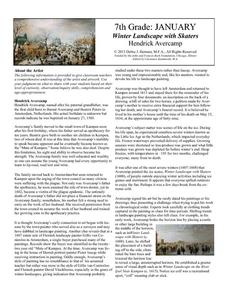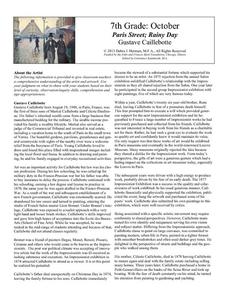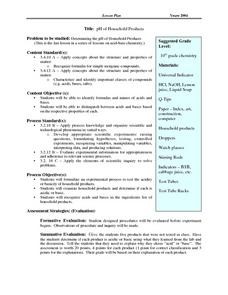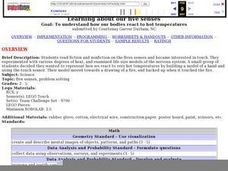Concordia University Chicago
Winter Landscape with Skaters by Hendrick Avercamp
In need of a quick set of ideas to use on a wintery day? Why not analyze Winter Landscape with Skaters with your class? After a thorough discussion, learners compare and contrast two paintings, research what curators do, draw landscapes,...
Concordia University Chicago
The Pietá by Michelangelo Buonarroti
Why is arts education so important? It builds critical thinking, analysis and creative problem-solving skills. Learners review the life of Michelangelo Buonarroti, and then analyze his piece, The Pieta. After that, they'll sculpt a human...
Concordia University Chicago
Tahitian Landscape by Paul Gauguin
Get ready to explore the piece Tahitian Landscape with your seventh graders. They discuss the primitive style, bright colors, and impressionism found in the work, as well as biographical information regarding Gauguin's life. There are...
Concordia University Chicago
Paris Street; Rainy Day by Gustave Caillebotte
Discuss the balance, color, emotion, and context of the painting Paris Street; Rainy Day by Caillebotte. After a deep discussion, let creativity run free in your class as learners create a dimensional piece that reflects a life change...
Debra J. Herman
The Blue Room by Susanne Valadon
Nearly anything can inspire art. Analyze The Blue Room by Susanne Valadon to help your learners understand that art is everywhere. They'll discuss the line, shape, color, and mood of the piece while attempting to better grasp its...
Curated OER
Scientific Investigation- Magnets
Students conduct a scientific investigation to determine if a magnet attracts paper clips through different materials. Students write out their procedures, collect data and present it in a table or chart, and analyze their results.
Curated OER
How Do We Forecast Weather?
Third graders investigate how scientists collect weather data in order to forecast the weather. They work in small groups in order to research one type of weather technology such as, satellite images, radar, surface observations, or...
Curated OER
pH of Household Products
Tenth graders are provided with a piece of paper such as index, art, construction, or computer coating it with a universal indicator. They use cotton swabs HCl and NaOH to draw a picture repeating the same process using lemon juice and...
Curated OER
Converting Metric Units and Prefixes
Students investigate the length of various objects. In this measurement lesson, students convert one metric unit to another. They explain the importance of a uniform system of measurement.
Curated OER
Classification
Students work in groups of 4-6 for the experiment/activity part of this exercise. They classify ten animals using the information on the picture to group the animals. Students develop descriptions, explanations, predictions, and models...
Curated OER
Newton’s Laws of Motion
Eighth graders explore the three laws of motion. For this physics lesson, 8th graders observe teacher demonstration and explain what happened in terms of Newton's Laws. They complete worksheet at the end of the lesson.
Curated OER
How Can You Study Things You Can’t See Like: Atoms?
Learners simulate how scientists studied things they can't see like atoms. In this chemistry lesson, students predict what is inside the numbered obsertainers. They design a way to investigate what's inside without opening it.
Curated OER
Fishkill
Students analyze data to determine the effect of thermal pollution on a certain species of fish. They graph temperature and dissolved oxygen and make inferences on the impact a change in temperature could have on the fish. As a class...
Curated OER
Learning About Our Five Senses
Students study the sense of touch and various degrees of heat. They design a model that displays how the human hand reacts to heat using a touch sensor.
Curated OER
Weather is Cool, Hot or Somewhere In-Between
Students access the Internet to record data on weather. They use email to answer a younger classes' questions about the weather.
Curated OER
Acid Precipitation
Young scholars test the acidity of unknown solutions. They use this information to make inferences from data given from recorded rainfall records to identify areas that receive the most acid rain.
Other popular searches
- Inquiry Based Science Lessons
- Inquiry Based Science Water
- Science Inquiry Based
- Inquiry Based Science Lessons
- Inquiry Based Science Sose
- Inquiry Based Science Souse
- Science Inquiry Based Learning

















